The Phases of the Moon
The Moon has eight phases in a lunar month: four primary and four intermediate phases.

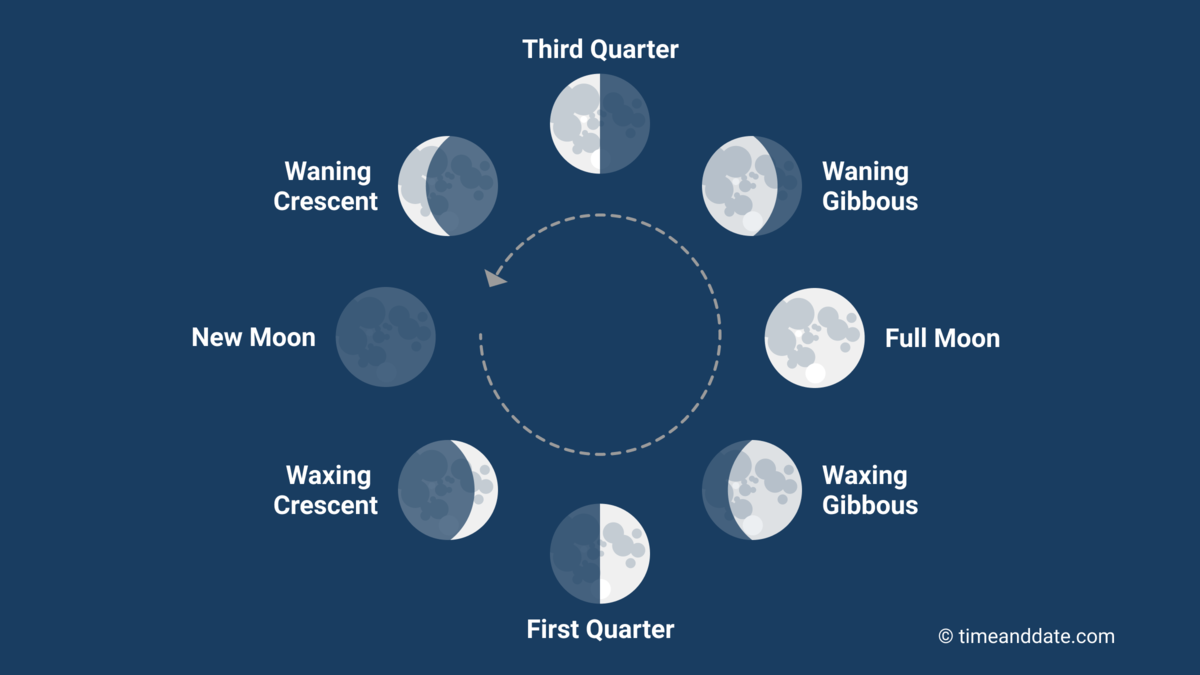
A Moon cycle, or a lunation, is the time the Moon travels through its lunar phases.
©timeanddate.com
March 24-25, 2024: Micro Moon and penumbral lunar eclipse
April 2024: Jupiter and Moon close approach
NEW! Video About Moon Phases
We show you how Moon phases work in our new video:
How do Moon phases work? We explain what happens and show how the Moon’s shape and moonrise times change over a lunar month.
©timeanddate.com
How Do Moon Phases Work?
Half of the Moon’s surface is always illuminated by sunlight. As the Moon orbits Earth, it changes how much of the lit-up side we can see.
The Moon: Our natural satellite
Moon Phases in Order
The eight Moon phases of a lunar month are divided into four primary and four intermediate (waxing and waning) Moon phases:
- New Moon
- Waxing Crescent Moon
- First Quarter Moon
- Waxing Gibbous Moon
- Full Moon
- Waning Gibbous Moon
- Third Quarter Moon
- Waning Crescent Moon
Primary Moon phases happen at a specific moment in time, while the time between these moments are the intermediate Moon phases. The lunar cycle lasts about 29.5 days, just under a calendar month.
Lunar calendar: next Full Moon and New Moon phase
New Moon
- Moon phase: primary
- Moonrise: around sunrise | Moonset: around sunset
- Illumination: 0%
- Position in space: the Moon is between the Sun and Earth
If the Moon’s path crosses the plane of Earth's orbit around the Sun (the ecliptic) while the Sun, Moon, and Earth are aligned at New Moon, a solar eclipse happens somewhere in the world.
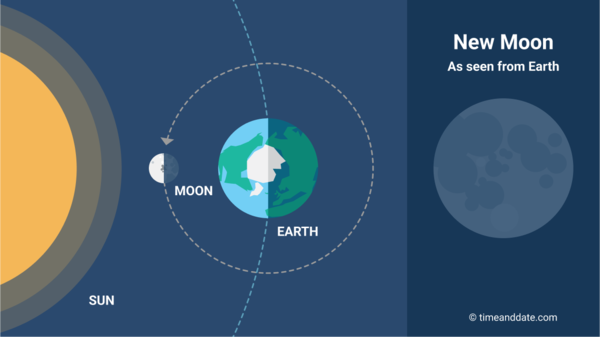

New Moon: The Moon is between the Sun and Earth. Only the dark unlit side of the Moon is facing toward us.
© timeanddate.com
Waxing Crescent Moon
- Moon phase: intermediate
- Moonrise: morning | Moonset: afternoon
- Illumination: 0.1% to 49.9%
- Orientation: right half is lit in Northern Hemisphere,
left half is lit in Southern Hemisphere - Position in space: moving from New Moon to First Quarter Moon
The Crescent phases can be a good time to see Earthshine, when sunlight reflected from Earth gives the dark areas of the Moon a faint glow.
Is the Moon upside-down in the other hemisphere?
First Quarter Moon (Half Moon)
- Moon phase: primary
- Moonrise: around midday | Moonset: around midnight
- Illumination: 50%
- Orientation: right half is lit in Northern Hemisphere,
left half is lit in Southern Hemisphere - Position in space: the Moon has gone one quarter of the way around Earth
Look for the First Quarter Moon in the blue afternoon sky.
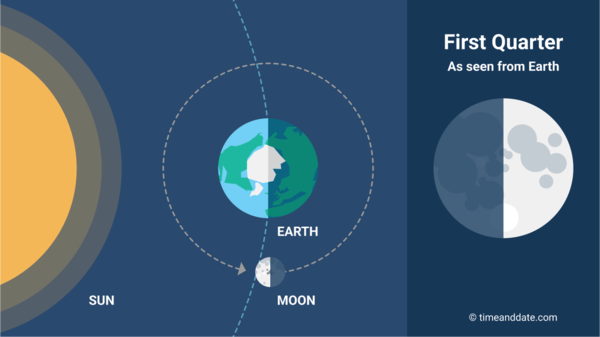

First Quarter Moon: The Moon is 90 degrees from the Sun, and exactly half of the Moon’s surface facing us is lit up.
© timeanddate.com
Waxing Gibbous Moon
- Moon phase: intermediate
- Moonrise: afternoon | Moonset: early morning
- Illumination: 50.1% to 99.9%
- Orientation: right half is lit in Northern Hemisphere,
left half is lit in Southern Hemisphere - Position in space: moving from First Quarter to Full Moon
A couple of days into the Waxing Gibbous Moon phase, you can see the Golden Handle.
Full Moon
- Moon phase: primary
- Moonrise: around sunset | Moonset: around sunrise
- Illumination: 100%
- Position in space: the Moon and the Sun are on opposite sides of Earth
If the Moon’s path crosses the plane of Earth's orbit around the Sun (the ecliptic) while the Sun, Earth, and Moon are aligned at Full Moon, a lunar eclipse happens on the night side of Earth.
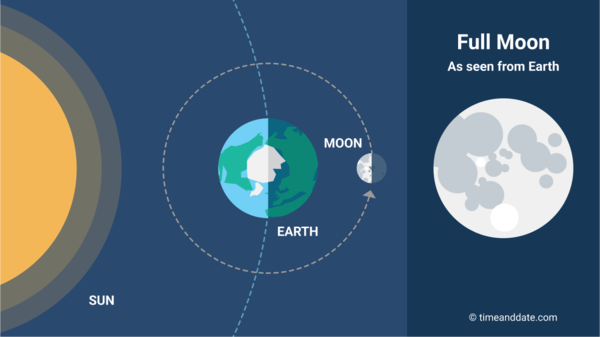

Full Moon: The Moon and the Sun are on opposite sides of Earth, and the side facing us is completely lit up.
© timeanddate.com
Waning Gibbous Moon
- Moon phase: intermediate
- Moonrise: evening | Moonset: morning
- Illumination: 99.9% to 49.9%
- Orientation: left half is lit in Northern Hemisphere,
right half is lit in Southern Hemisphere - Position in space: moving from Full Moon to Third Quarter Moon
The Moon can still look quite full a few days after Full Moon in the Waning Gibbous phase.
Third Quarter Moon (Half Moon)
- Moon phase: primary
- Moonrise: around midnight | Moonset: around midday
- Illumination: 50%
- Orientation: left half is lit in Northern Hemisphere,
right half is lit in Southern Hemisphere - Position in space: the Moon has gone three quarters of the way on its orbit around Earth
The Third Quarter Moon begins the last quarter of the lunar cycle.
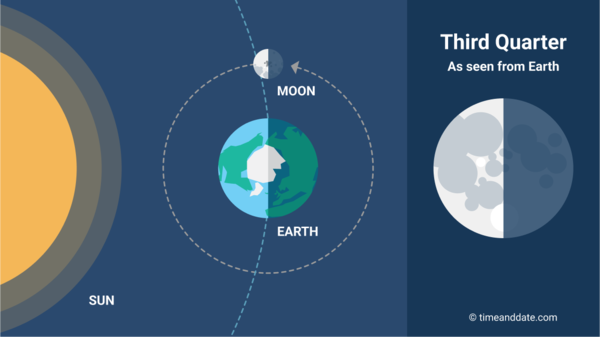

Third Quarter: The Moon has completed three quarters of its orbit around Earth, and exactly half of its surface facing us is lit up.
© timeanddate.com
Waning Crescent Moon
- Moon phase: intermediate
- Moonrise: early morning | Moonset: afternoon
- Illumination: 49.9% to 0.1%
- Orientation: left half is lit in Northern Hemisphere,
right half is lit in Southern Hemisphere - Position in space: moving from Third Quarter to New Moon
The Crescent phases can be a good time to see Earthshine, when sunlight reflected from Earth gives the dark areas of the Moon a faint glow.